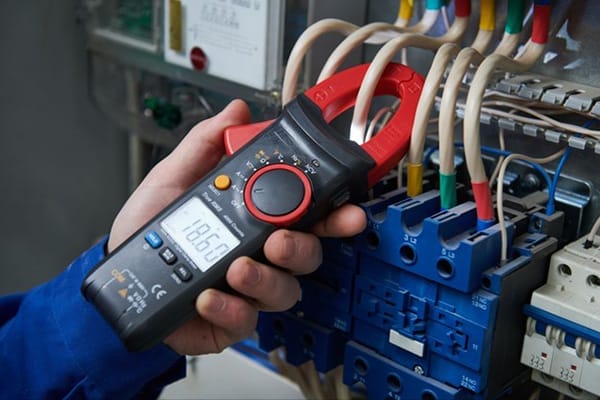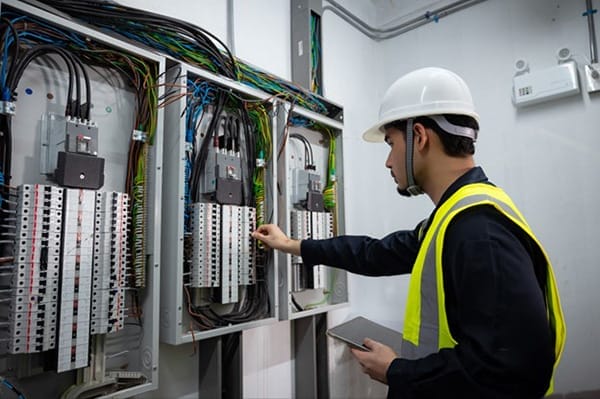For businesses and homeowners alike, saving energy and saving money are often one and the same. And with climate change an ever-growing concern, it’s more important than ever to optimize energy efficiency. One way to do this is through an energy audit. Learn more about what an energy audit is, how it works, who should get one, and much more.
What Is an Energy Audit?
In a nutshell, an energy audit is an expert evaluation of a building’s energy use and performance, whether it’s a large business or a single-family home. The auditor will analyze energy consumption data, conduct on-site inspections, and assess the performance of various energy systems. The goal is to identify areas where the building can implement energy-saving measures.
During an energy audit, trained professionals thoroughly examine a building’s energy usage patterns. They collect data on energy consumption — such as electricity, natural gas, and water usage — and analyze it to identify trends and patterns. This analysis helps determine where energy is wasted and which improvements can be made.
Energy audits are important because they can identify affordable ways to reduce energy consumption and lower energy bills. With this information, people can make informed decisions about energy-efficient equipment, technologies, and practices.
How Can an Energy Audit Help You?
Implementing an energy audit’s recommendations can lead to significant energy savings and money savings. For example, upgrading to energy-efficient lighting, such as LED lights, can reduce electricity consumption. Additionally, improving insulation with weatherstripping and other upgrades can reduce heating and cooling costs.
On top of the lower electricity costs associated with these changes, homes or businesses can also contribute to environmental sustainability by reducing the greenhouse gas (GHG) emissions created through energy production and use. According to the U.S. Department of Energy, homeowners can save 5-30% on monthly energy bills while also ensuring the home’s health and safety.
Energy audits can also uncover unknown issues impacting the well-being of a building’s occupants. For instance, poor insulation can lead to drafts and uncomfortable temperature fluctuations. Energy audits can also help buildings comply with energy efficiency regulations and standards. Many regions have energy codes that buildings must meet. Building owners can help ensure their properties meet these requirements through an energy audit and avoid potential penalties or fines.
Pro tip: Learn about energy-saving practices in the workplace and other energy-saving practices and home improvements you can adopt now.
What Are Different Types of Energy Audits?
There are several types of energy audits and which one you choose depends on the scope of what you need and your objectives. Here’s a closer look at three types of energy audits.
1. Walk-Through Energy Audit
A walk-through energy audit, sometimes called a screening audit, is a preliminary assessment that involves a visual inspection of a home or commercial building’s energy systems. It provides a general idea of the building’s energy performance and identifies some of the more obvious areas for improvement, such as adjusting thermostat settings or purchasing EPA-approved Energy Star appliances.
During the walk-through, an energy auditor will visually inspect various energy-related components, such as the building envelope, which includes walls, windows, and doors. The auditor is checking for obvious air leaks or insulation issues that could lead to energy loss. They will also assess the lighting systems, heating, ventilation, and air conditioning (HVAC) systems, and other energy-consuming equipment for obvious inefficiencies or outdated technology.
The auditor may also interview building occupants to gather information about energy usage patterns and identify any concerns or issues. This type of audit is typically less time-consuming and less expensive than other types. It also generally requires no testing with instruments, making it a good starting point for energy efficiency improvements.
2. Diagnostic Energy Audit
A diagnostic energy audit dives deeper into the assessment process. It involves collecting and analyzing energy consumption data, conducting on-site measurements and inspections, and using advanced diagnostic tools to identify energy-saving opportunities. This will give the building owner a detailed analysis of the building’s energy performance.
In a diagnostic energy audit, the energy auditor collects energy consumption data from utility bills, sub-metering systems, or other monitoring devices and analyzes this data. They look to identify energy usage trends, such as peak demand periods or periodic excessive energy consumption.
On top of this, the auditor will also perform on-site measurements and inspections to gather more detailed information about the building’s energy systems. This often includes advanced tools, such as using infrared cameras to detect insulation gaps or air leaks, performing blower door tests to measure air tightness, or using power quality analyzers to assess the efficiency of electrical systems.
This assessment may go a step further by including advanced diagnostic tools — like energy modeling software or building energy simulation programs — to simulate energy-saving scenarios. This type of audit provides a comprehensive assessment of the building’s energy performance and helps prioritize energy efficiency improvements.
Enter your ZIP Code and compare electricity rates
3. Comprehensive Energy Audit
A comprehensive energy audit, sometimes called an investment-grade energy audit, is the most detailed and complete energy audit type. Like a diagnostic energy audit, it involves a thorough evaluation of all energy systems and components, detailed measurements and data analysis, and the development of a comprehensive energy management plan. This type of audit goes a step further with a detailed roadmap for energy efficiency improvements and a financial analysis.
In a comprehensive energy audit, the energy auditor will perform all the tasks included in the diagnostic audit, including setting up a site visit and performing all the advanced tests needed to find energy inefficiencies. They also analyze historical data, looking for energy usage trends.
Based on the findings from the inspections and measurements, the auditor will develop a comprehensive energy management plan. This plan will outline specific energy-saving measures, such as upgrading insulation or replacing inefficient appliances. It will also provide cost estimates, payback periods, and potential energy savings for each recommended measure.
What Are the Goals of an Energy Audit and What Information Does It Provide?
An energy audit assesses a building’s energy usage and efficiency and involves a detailed examination of energy systems, equipment, and consumption patterns to identify potential energy-saving opportunities. Some more in-depth audits also recommend upgrades or renovations.
Here’s a quick breakdown of an energy audit’s goals:
- Identify cost- and energy-saving opportunities
- Assess the performance of energy systems, equipment, and/or appliances
- Evaluate the building’s energy consumption patterns
- Recommend energy-efficient upgrades and renovations
An energy audit involves gathering various data and information to provide a comprehensive analysis. Some of the valuable information that an energy audit provides includes:
- Energy consumption data and patterns: An auditor will analyze energy bills and usage data to provide insights into the building’s energy usage.
- Identification of energy-saving opportunities: An auditor will closely examine the building’s energy systems, equipment, and operations and identify where you can make improvements. This may include upgrading lighting systems, optimizing HVAC systems, or implementing renewable energy appliances or technologies.
- Performance evaluation of energy systems and equipment: An energy audit assesses the performance of various energy systems and equipment, such as HVAC systems, lighting systems, and insulation. The audit can determine if any upgrades or replacements are needed by evaluating their efficiency and effectiveness.
- Estimates of potential energy and cost savings: Based on the findings, the auditor will provide details on potential energy-efficient measures and upgrades that can be implemented.
How Is an Energy Audit Conducted and What Tools Are Used?
An energy audit can be a very in-depth process with many moving parts. They typically involve the following steps:
- Collecting and analyzing energy consumption data
- Conducting on-site inspections and measurements
- Assessing the performance of energy systems and equipment
- Identifying and prioritizing energy-saving opportunities
- Developing an energy management plan
To complete a full energy audit — one that goes beyond just a walk-through audit — an auditor will need specific tools and instruments to gather real-time data.
Here are some common energy audit tools and their functions:
- Power meters: Auditors will use these tools to measure the energy consumption of items and equipment, such as a hot water heater or heat pump. It’ll help them determine if something is drawing excessive power due to age or mechanical fault.
- Thermal imaging cameras: These cameras allow auditors to see temperature fluctuations due to poor insulation or inefficient air sealing around windows and doors. This air leakage can lead to big spikes in energy consumption in hot and cold seasons.
- Airflow and pressure meters: An auditor will use this tool to measure airflow from heating and cooling system ducts to detect any inefficiencies that need repair.
- Energy modeling software: This software uses data and estimations to show the return a building owner will see by making the auditor’s recommended changes.
What Is a Certified Energy Auditor and What Are Their Qualifications?
A certified energy auditor (CEA) is a professional trained and qualified to conduct energy audits. They’re experts in assessing energy consumption for homeowners and commercial buildings, identifying opportunities to lower electricity costs, and developing energy management strategies and recommending energy efficiency upgrades.
Becoming a CEA requires specific education, training, and more. Let’s review the requirements.
Education and Experience Requirements
No baseline education requirements exist to become a CEA, but the more education you have, the less experience you need. Here’s how education impacts experience requirements when applying to become a CEA:
- No formal education: You’ll need over 10 years of related experience
- Two-year associate’s degree: You’ll need over five years of related experience
- Four-year degree in an unrelated field: You’ll need over four years of related experience
- Four-year degree in a related field: You’ll need over three years of related experience
The one exception to the education and experience requirements is if you’re already a Certified Energy Manager (CEM). In this case, you’ll need three or more years of experience regardless of your education level.
Training In-Lieu of Education and Experience
If you lack the education and experience requirements listed above, you can still apply to be a CEA In-Training (CEA-IT). These relatively short courses — generally a week or less — give you the basic understanding needed to train to become a CEA and gain the necessary experience. The CEA-IT certification is good for six years, giving you enough time to meet all the requirements to become a full CEA.
Apply and Pass the Exam
Once you’ve met all the requirements to become a CEA or plan to become a CEA-IT and complete the initial training, you can apply and take the required exam. The examination fee is $500 and is administered through remote proctoring.
Renew Your Certification
Once you’re officially a CEA, you must renew your certification every three years. This costs $300.
How Often Should Buildings Undergo Energy Audits?
The frequency of energy audits depends on multiple factors, such as the size and complexity of the building, its energy consumption patterns, and the rate of technological advancements. In general, it’s recommended to conduct energy audits at least once every three to five years to ensure ongoing energy performance optimization.
Keep in mind that some states and regions have energy audit requirements. For example, New York City requires buildings with over 50,000 gross square feet to have a complete energy audit every 10 years.
Save Money and Energy with an Energy Audit
If your building has never had an energy audit or it’s been a long time since your last one, you may have some hidden problem areas leading to high energy usage. An energy audit can spot these issues and be a big energy saver in the long run. While there will be upfront costs for commercial or home improvements, the long-term savings can be well worth the investment.
If you’re looking for ways to save, you may also want to consider switching energy suppliers. Here at Energy Savings, you can browse through different residential and business energy plans in Texas to meet your needs and help save you on energy costs in more ways than one.
Brought to you by energysavings.com
All images licensed from Adobe Stock.




